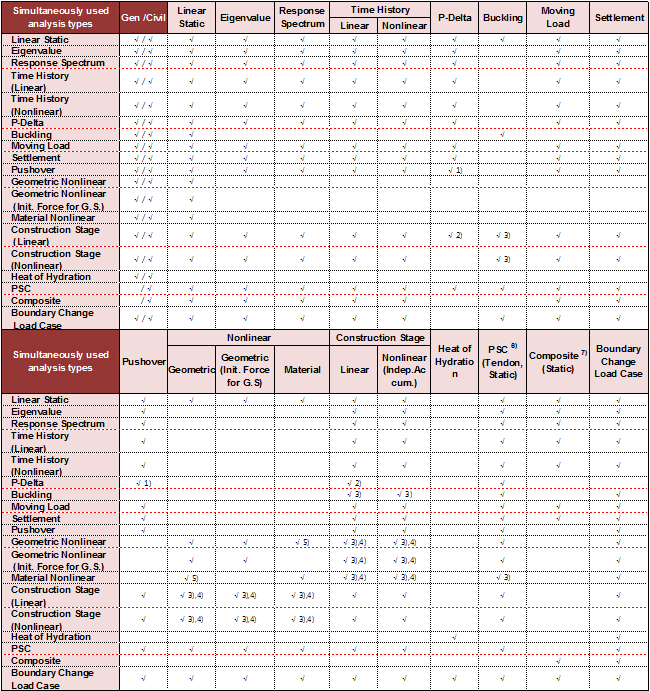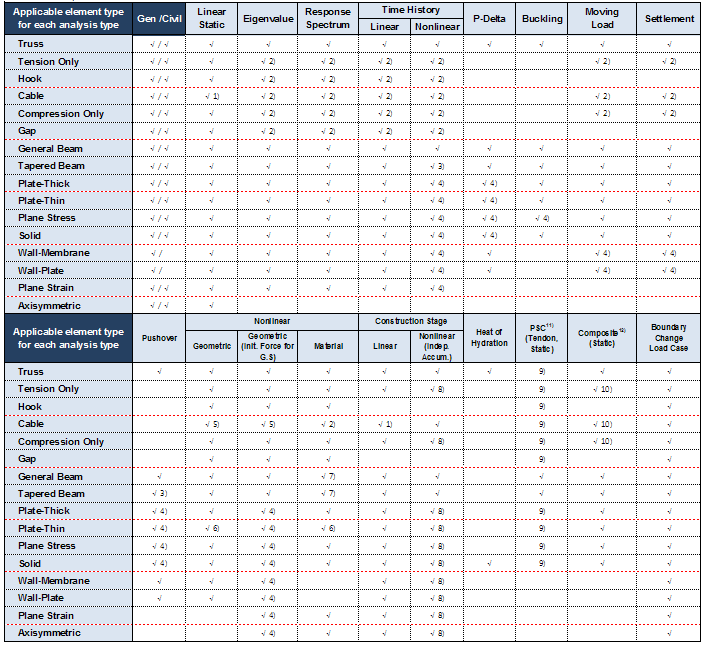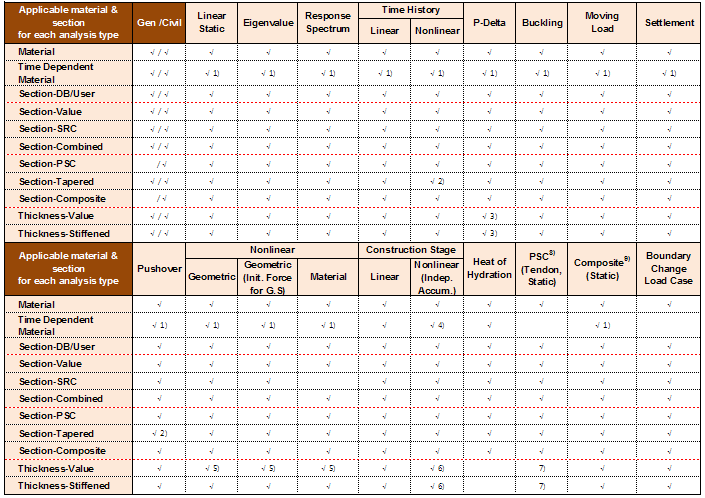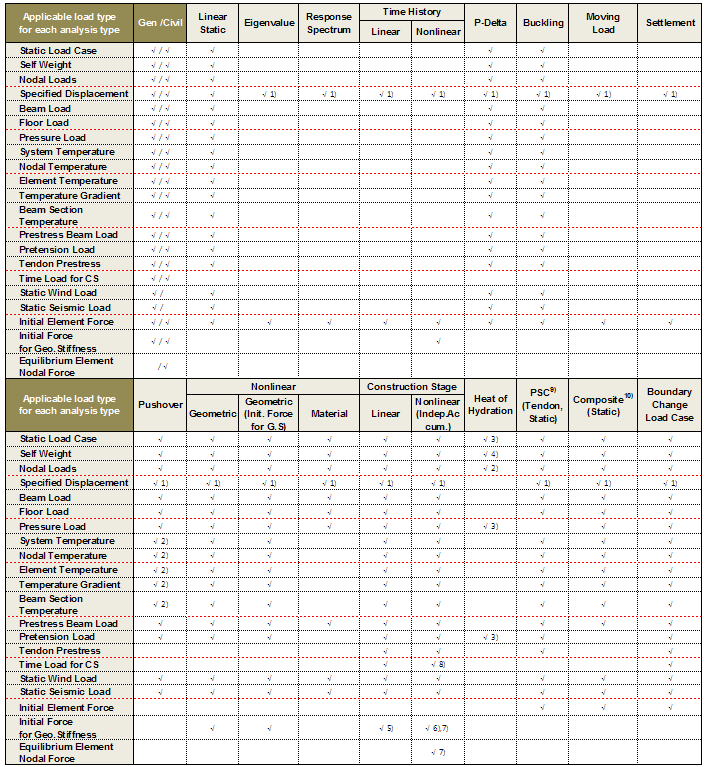Analysis Guide
midas Gen and Civil are general purpose finite element analysis software. The significant modeling features based on the various element types, material/section DBs, boundary conditions and load types enable the practicing engineers to undertake virtually all types of structural analyses. However, some restrictions apply to the features in that some of the features cannot be used simultaneously. For example, Support Settlement Analysis and Heat of Hydration Analysis cannot be performed simultaneously. Also Plane Strain element cannot be applied to Bucking Analysis.
The following tables show such restrictions:
1. Analysis types, which can be used simultaneously
2. Elements, which can be used, by analysis types
3. Materials and sections, which can be used, by analysis types
4. Boundary conditions, which can be used, by analysis types
5. Load cases, which can be used, by analysis types
-
Analysis types, which can be used simultaneously

Note
1) Pushover analysis itself includes the option of P-Delta effect.
2) Construction stage analysis itself includes the option of P-Delta effect.
3) Both analyses can be performed simultaneously. However each analysis is independently performed.
4) Nonlinear analysis defined in the 'Construction Stage Analysis Control' dialog is reflected in the construction stages only. Nonlinear analysis defined in the 'Nonlinear Analysis Control' dialog is reflected in the postCS only.
5) Material nonlinear analysis considering geometric nonlinearity can be performed for plate elements only.
6) In case tendon profile data are entered
7) In case 'Load Cases for Pre-Composite Section' data are entered (Load > Composite Section Analysis Data > Load Cases for Pre-Composite Section)
-
Elements, which can be used, by analysis types

Note
1) Cable elements are considered as equivalent truss elements for linear analysis.
2) Cable elements are considered as truss elements.
3) Tapered beam elements are considered as prismatic beam elements (averaged).
4) Elastic stiffness of the corresponding element is reflected in the analysis.
5) Cable elements are considered as elastic catenary elements for geometric nonlinear analysis.
6) Thin plate elements are considered as thick plate elements.
7) Non-composite steel section is only supported for material nonlinearity.(Channel, I-Section, T-Section, Box, Pipe, Rectangle, Round section only.)
8) Geometric nonlinear analysis can be carried out for each construction stage independently. 'Accumulative Stage' option cannot be applied.
9) Tendon cannot be applied except for beam elements.
10) The corresponding elements are considered as truss elements.
11) In case tendon profile data are entered
12) In case 'Load Cases for Pre-Composite Section' data are entered (Load > Composite Section Analysis Data > Load Cases for Pre-Composite Section)
-
Materials and sections, which can be used, by analysis types

Note
1) Analysis can be performed, but time dependent material properties are not reflected.
2) Tapered beam elements are considered as prismatic beam elements (averaged).
3) Elastic stiffness of the corresponding element is reflected in the analysis. Geometric stiffness is not considered.
4) Geometric nonlinear analysis can be carried out with accumulated effects of the models of each construction stage.
5) Thin plate elements are considered as thick plate elements.
6) Geometric nonlinear analysis can be carried out for each construction stage independently. 'Accumulative Stage' option cannot be applied.
7) Tendon cannot be applied except for beam elements.
8) In case tendon profile data are entered
9) In case 'Load Cases for Pre-Composite Section' data are entered (Load > Composite Section Analysis Data > Load Cases for Pre-Composite Section)
-
Boundary conditions, which can be used, by analysis types


Note
1) Corresponding links are considered as elastic links of general type.
2) Nonlinear type point spring supports are considered as linear type in the analysis.
3) Inelastic hinge properties can be assigned to the Spring Type of General Link.
4) Properties of the corresponding boundary condition cannot be changed during construction stage.
5) General Link Property changes must be defined in the 'Change General Link Properties', and the changes can be applied in the Boundary Change Assignment to Load Cases/Analyses.
6) In case tendon profile data are entered
7) In case 'Load Cases for Pre-Composite Section' data are entered (Load > Composite Section Analysis Data > Load Cases for Pre-Composite Section)
-
Load cases, which can be used, by analysis types

Note
1) If specified displacements are assigned to a node, the relevant degrees-of-freedom of the node are automatically constrained even for other load cases that do not contain specified displacements.
2) If the temperature loads are entered as an Initial Load, pushover analysis cannot be performed.
3) Static load cases to be considered in the heat of hydration analysis must be defined as 'Construction Stage Load (CS)' as a load type.
4) Heat of hydration analysis itself includes the option of self weight load.
5) If both 'Initial Forces for Geometry Stiffness' and 'Equilibrium Element Nodal Forces' are entered simultaneously, only 'Equilibrium Element Nodal Forces' are applied.
6) If both 'Initial Forces for Geometric Stiffness' and pretensions in the cable elements (Model>Elements>Create elements) are entered, only pretensions in the cable elements are applied.
7) Geometric nonlinear analysis can be carried out for each construction stage independently.
8) Geometric nonlinear analysis is carried out with accumulated effects of the models of each construction stage.
9) In case tendon profile data are entered
10) In case 'Load Cases for Pre-Composite Section' data are entered (Load > Composite Section Analysis Data > Load Cases for Pre-Composite Section)